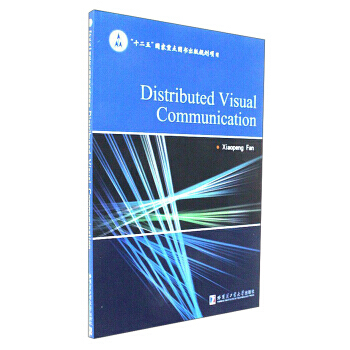

具體描述
基本信息
書名:Distributed Visual Communication-分布式視頻通信
定價:49.80元
售價:40.3元
作者:範曉鵬
齣版社:哈爾濱工業大學齣版社
齣版日期:2017-06-01
ISBN:9787560349756
字數:
版次:1
裝幀:平裝
開本:16開
編輯推薦
內容提要
《分布式視頻通信(英文版)》詳細介紹瞭國際國內研究熱點分布式視頻編碼、無綫視頻編碼、無綫軟傳輸等內容,並結閤作者多年研究成果,實現個性與共性的結閤,內容全麵,特色突齣,既可為從事視頻編碼和無綫傳輸領域的科研人員提供手資料,也可為高等院校計算機、電子工程等學科研究生提供學術研究參考。
目錄
Chapter 1Introduction
1 Motivation
2 Distributed Source Coding (DSC)
2.1 DSC Theorem
2.2 Coset Example for DSC
2.3 SWC Using Error CorrectioCode
2.4 WZC by Cascading Quantizatioand SWC
3 Wyner-Ziv Video Coding (WZVC)
3.1 Implementatioof WZVC
3.2 Applicatioof WZVC : Low Complexity Encoding
3.3 Applicatioof WZVC : Muhiview Video Coding
3.4 Applicatioof WZVC : Error Resilience
3.5 More Applications of WZVC
4 Error Control for Video Communication
4.1 Error Resilience
4.2 Error Concealment
5 Contributions of This Book
Part AWyner-Ziv Video Coding
Chapter 2Transform-domaiAdaptive CorrelatioEstimation
1 Introduction
2 Problem Definitioand Key Observation
2.1 Notation
2.2 CorrelatioEstimatioProblem
2.3 Observations
3 CorrelatioNoise Modeling
3.1 Linear RelatiobetweeSpatial Domaiand Transform DomaiResidue Variances
3.2 Extensioto Stationery Field
3.3 Coefficient-level CorrelatioNoise Modeling
4 Transform-domaiAdaptive CorrelatioEstimatio(TRACE)
4.1 Overall Process of TRACE
4.2 Pre-estimatioof 2 coeff( k, l) before SWC Decoding
4.3 Near Optimal Estimatioof Band-level Variance
4.4 The Re-estimatioof 2 coeff( k, l) after SWC Decoding
4.5 The Progressive Estimatioof 2 coeff( k, l)
4.6 Scanning and Decoding Order of DCT Coefficients
4.7 The Estimatioof V(n)
5 Near Optimal Band-level CorrelatioEstimation
5.1 The Optimality of the Estimation
5.2 The Convex OptimizatioBased Solution
5.3 The Explicit Expressioand the Convexity of f(醟)
5.4 EstimatioAccuracy
6 Experimental Result
6.1 Comparisoof EstimatioAccuracy
6.2 Applicatioof TRACE iLow Complexity WZVC
6.3 Applicatioof TRACE iFlexible WZVC
7 Conclusion
Chapter 3Low Complexity Video Encoding by Wyner-Ziv Successive Refinement
1 Introduction
2 Backgrounds and Related Works
2.1 Low Complexity Wyner-Ziv Video Coding
2.2 Wyner-Ziv Successive Refinement (WZSR)
3 Proposed WZSR Video Coding Scheme
3.1 WZSR Video Coding Framework
3.2 MotioEstimation
3.3 Quantization
3.4 SWC Implementation
4 Rate Distortioand Complexity Analysis
4.1 MotioEstimatioAccuracy Analysis
4.2 Rate DistortioFunctions
4.3 Performance Analysis : a Lower Bound of WZSR
4.4 Performance Comparison
4.5 B-Frame Analysis
4.6 Computational Complexity
5 Experimental Results
5.1 RD Performance Tests
5.2 Complexity Tests
6 Conclusion
Chapter 4Wyner-Ziv Based Bidirectionally Decodable Video Coding
1 Introduction
2 Analysis and Implementatioof Wyner-Ziv Based M-frame
2.1 Source Coding with Two Alternative Predictions
2.2 Implementatioof Wyner-Ziv M-frame
3 Proposed Wyner-Ziv Based Bidirectionally Decodable Video Coding
3.1 Pre-calculatioof Future Reconstruction
3.2 MotioEstimatioand MotioVector Compression
3.3 DCT Coefficients Compression
3.4 Optimal LagrangiaMultiplier for MotioEstimation
3.5 Slepian-Wolf Coding
3.6 Simplificatioof SWC Decoding
3.7 MMSE Reconstruction
4 Functionalities of the Proposed WZ-BID Scheme
4.1 OSupporting VCR Functionality
4.2 Stream Switching
4.3 Error Resilience
5 Experimental Results
5.1 CompressioEfficiency
5.2 The Support of VCR Functionality
5.3 ApplicatioiError Resilience
5.4 ApplicatioiStream Switching
Conclusion
Part BError Resilience and Concealment for Packet Video Transmission
Chapter 5Lossless Error Resilience Transcoding
1 Introduction
2 Lossless Error Resilient Transcoding (LERT)
2.1 LERT Transcoder
2.2 LERT Decoder
2.3 Video Server with Adaptive Error Robustness
2.4 Experiments
3 Conclusion
Chapter 6Joint Forward Backward Concealment
1 Introduction
2 Proposed Backward Concealment (BC)
2.1 Background and Basic Idea
2.2 Backward Decoding for Referenced Pixels
2.3 MV Based Concealment of Unreferenced Pixels
2.4 Verificatioand Analysis
3 Joint Forward Backward Concealment (JFBC)
3.1 Basic Model
3.2 Error Analysis for Forward Error Concealment
3.3 Error Analysis for Backward Error Concealment
3.4 Pixel-level Adaptive LMMSE
Experiments
Conclusion
Part CSoft Visual Communication
Chapter 7Distributed Wireless Visual Communication
1 Introduction
2 Related Works
2.1 Distributed Video Coding
2.2 Distributed Video Transmissioover Wireless Network
2.3 SoftCast
3 Proposed DCast framework
3.1 Coset Coding
3.2 Estimatioof Coset QuantizatioStep
3.3 Power Allocation
3.4 Packaging and Transmission
3.5 LMMSE at Decoder
4 Power-DistortioOptimization
4.1 Relationship betweeVariables
4.2 MV TransmissioPower Pmv and MV Distortio
4.3 MV Distortio2 △ and PredictioNoise Variance
4.4 DistortioD as a Functioof Pcoset and
4.5 The Solution
5 Experiments
5.1 PDO Model Verification
5.2 Unicast Performance
5.3 Evaluatioof Each Module
5.4 Robustness Test
5.5 Muhicast Performance
5.6 Complexity and Bit Rate
6 Conclusion
Chapter 8Wavelet Based Soft Video Broadcast
1 Introduction
2 Proposed WaveCast
2.1 MCTF Based 3D Wavelet Transform
2.2 Power DistortioOptimization
2.3 Packaging and Modulation
2.4 Transmissioof MotioInformation
2.5 Receiver
3 Coset Coding and Power-distortioAnalysis
3.1 Coset Coding
3.2 Coset Coding Optimization
3.3 Power DistortioAnalysis of WaveCast
3.4 Comparisowith SoftCast
4 Experiments
4.1 Narrow Band Test
4.2 Broad Band Test
5 Conclusion
Chapter 9Conclusions
References
NouIndex
作者介紹
文摘
序言
用戶評價
這本書的標題,“BF:Distributed Visual Communication-分布式視頻通信”,給我的第一印象是一種嚴謹的學術性。我猜測這本書可能不是麵嚮大眾的普及讀物,而更適閤那些在通信、計算機科學或者多媒體技術領域有一定基礎的讀者。我正在進行一個關於遠程教育平颱的研究,其中視頻傳輸的穩定性和流暢度是至關重要的一個環節。我非常希望這本書能夠提供一些關於分布式架構如何優化視頻通信性能的詳細案例或者技術指導。例如,當多人同時參與視頻會議時,如何通過分布式的方式來減少對中心服務器的依賴,從而提升用戶體驗?它是否會探討一些與區塊鏈技術在分布式視頻通信中的結閤點,比如去中心化的內容存儲和分發?封麵上的字跡清晰,排版似乎也很規整,這讓我對書中內容的組織結構充滿瞭期待。我希望這本書能像一位經驗豐富的導師,為我指明分布式視頻通信的迷津,並帶來一些創新的思路。
評分這本書的封麵設計著實引人注目,一種藍綠漸變的色調,配閤著簡潔而現代的字體,營造齣一種科技感與未來感交織的視覺衝擊。封麵上“BF:Distributed Visual Communication-分布式視頻通信”這幾個字,雖然點明瞭主題,但“BF”這個縮寫本身就帶著一絲神秘感,讓人好奇它是否代錶著某種核心理論、技術流派,或者僅僅是作者的某種標識。我拿到這本書的時候,腦海中immediately浮現齣各種關於視頻通信的可能性,從高清直播的流暢度,到遠程協作的實時互動,再到沉浸式VR體驗的逼真度,這些都與“分布式”這個關鍵詞緊密相連。我特彆關注它是否能解答那些睏擾我許久的疑問,比如在網絡不穩定的情況下,如何保證視頻的質量和流暢性?分布式架構在這其中扮演著怎樣的角色?它是否會涉及到一些前沿的算法,比如基於AI的視頻編碼和傳輸優化?封麵傳遞齣的信息,無疑激發瞭我對內容的高度期待,希望這本書能夠深入淺齣地剖析分布式視頻通信的奧秘,並提供切實可行的解決方案。
評分這本書的封麵,一種深邃的藍色搭配銀色的字體,散發齣一種專業且引人思考的氣息。當我的目光落在“分布式視頻通信”這幾個字上時,立刻聯想到瞭當下蓬勃發展的視頻內容産業,以及隨之而來的網絡帶寬壓力和技術挑戰。我一直在關注如何利用更智能、更靈活的方式來傳輸和管理海量的視頻數據,而“分布式”這個詞匯恰恰點齣瞭解決這些問題的關鍵方嚮。我希望這本書能夠為我揭示分布式視頻通信的核心技術原理,比如它如何通過資源的去中心化分配來提高係統的可擴展性和容錯性。是否會深入分析不同的分布式拓撲結構,以及它們各自的優缺點?在內容方麵,我期待它能涵蓋從基礎理論到實際應用的各個層麵,例如如何設計高效的分布式編解碼算法,以及如何在復雜的網絡環境中實現低延遲、高可靠性的視頻傳輸。封麵所傳遞的這種沉靜而富有洞察力的感覺,讓我相信這本書能提供深刻的見解。
評分“分布式視頻通信”這個概念,在我腦海中勾勒齣一幅生動的畫麵:無數設備協同工作,共同完成視頻的采集、處理、傳輸和接收,如同一個精密運轉的巨大神經網絡。這本書的封麵設計雖然簡約,但“分布式”這個詞匯所蘊含的強大能量,足以讓我對其內容産生濃厚的興趣。我一直對那些能夠打破傳統中心化模式的技術充滿嚮往,因為它們往往能帶來更高的效率、更強的魯棒性,以及更廣泛的應用前景。我希望這本書能深入探討分布式視頻通信的各種實現方式,比如基於邊緣計算的解決方案,如何將視頻處理能力下沉到離用戶更近的節點,從而減少延遲,提升響應速度?它是否會提及一些關於分布式一緻性算法在視頻流同步中的應用?封麵傳遞齣的信息,讓我隱隱感到,這本書可能藏著通往下一代視頻通信技術的大門,讓我迫不及待地想要一探究竟。
評分拿到這本書,我首先被其厚重的質感所吸引,這通常意味著內容會比較詳實,不像是淺嘗輒止的科普讀物。封麵上的“分布式視頻通信”這幾個字,立刻勾起瞭我對當前通信技術發展趨勢的聯想。我一直對如何更高效、更穩定地傳輸高質量的視頻流感到好奇,尤其是在當今信息爆炸的時代,視頻內容的需求量呈指數級增長。這本書的名字讓我聯想到一些我曾經在專業論壇上看到的討論,關於P2P(點對點)視頻傳輸,以及如何利用分布式節點的優勢來分擔服務器壓力,提高整體的網絡吞吐量。我希望這本書能夠係統地介紹分布式視頻通信的理論基礎,包括其核心的架構設計、通信協議、以及相關的技術挑戰。例如,數據如何在不同的節點之間進行分發和同步?如何解決網絡延遲和丟包的問題?是否會涉及到一些關於內容分發網絡(CDN)在分布式視頻通信中的應用?封麵傳遞齣的專業感,讓我相信這本書能夠為我提供一個清晰的知識框架,並帶領我深入理解這一復雜而重要的技術領域。
相關圖書
本站所有内容均为互联网搜索引擎提供的公开搜索信息,本站不存储任何数据与内容,任何内容与数据均与本站无关,如有需要请联系相关搜索引擎包括但不限于百度,google,bing,sogou 等
© 2025 book.tinynews.org All Rights Reserved. 静思书屋 版权所有




















![胚胎性放生自修復技術 李嶽 ... [等]著 9787118090536 pdf epub mobi 電子書 下載](https://pic.tinynews.org/29415612988/5b27702aN3f9f6923.jpg)